After the Treaty of Pressburg, which was a result of the Battle of Austerlitz and was signed on 26 December 1805, Napoleon decided to create a satellite body of states from several German nations under a confederation which was called the Confederation of the Rhine. Before, these territories were part of the Holy Roman Empire but after his defeat at the Battle of Austerlitz the Holy Roman Emporer was forced to cede various parts of his territory and recognize some monarchs (the kings of Bavaria and Württemberg) which previously were his legal subordinates because kings within the Empire were legally not allowed.
Napoleon merged 16 states into the Confederation of the Rhine which was officially formed with the Treaty of the Confederation of the Rhine which was signed on 12 July 1806. Initially the following 16 states joined the Confederation of the Rhine:
- Grand Duchy of Baden

- Kingdom of Bavaria

- Grand Duchy of Berg

- Grand Duchy of Hesse-Darmstadt

- Principality of Regensburg

- Kingdom of Württemberg

- Duchy of Arenberg

- Principality of Hohenzollern-Hechingen

- Principality of Hohenzollern-Sigmaringen

- Principality of Isenburg

- Principality of Leyen

- Principality of Liechtenstein

- Nassau-Usingen
 (forms the Duchy of Nassau
(forms the Duchy of Nassau  with Nassau-Weilburg)
with Nassau-Weilburg) - Nassau-Weilburg
 (forms the Duchy of Nassau
(forms the Duchy of Nassau  with Nassau-Usingen)
with Nassau-Usingen) - Salm-Salm (forms the Principality of Salm
 with Salm-Kyrburg)
with Salm-Kyrburg) - Salm-Kyrburg (forms the Principality of Salm
 with Salm-Salm)
with Salm-Salm)
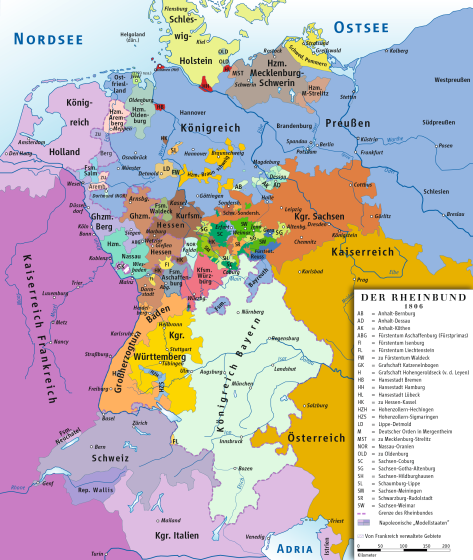
The head of state of the Confederation of the Rhine was Napoleon I himself under the title of Protector of the Confederation of the Rhine. However, it was governed by a Prince-Primate (the “first” of princes, i.e. a primus inter pares – first among equals), Karl von Dalberg. The Prince-Primate was also the Chairman of the Diet of the Confederation and President of the College of Kings. The Diet was supposed to act as some sort of Parliament but it has never assembled.
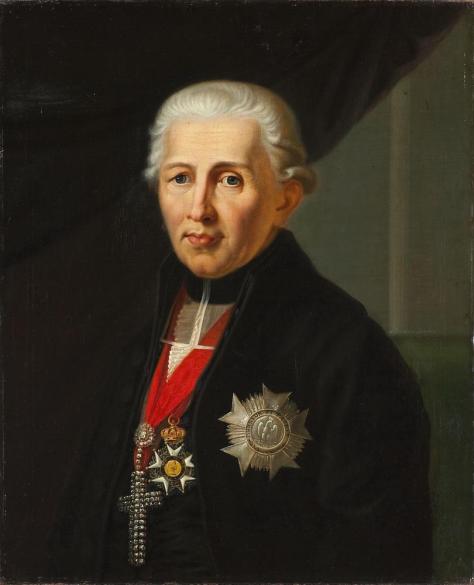
In August 1806 Prussia, also a former member of the Holy Roman Empire, diceded to go to war with France. After Napoleon in October 1806 ordered all his troops east of the Rhine to attack Prussia, the Prussians lost two battles on 14 October, Jena and Auerstadt, and thirteen days later the French marched into Berlin. The Prussians were defeated and more nations joined the Confederation of the Rhine.
On 15 September 1806 the Grand Duchy of Würzburg ![]() already joined, but after the defeat of Prussia the following territories joined in the following months:
already joined, but after the defeat of Prussia the following territories joined in the following months:
- Kingdom of Saxony

- Duchy of Saxe-Weimar

- Duchy of Saxe-Coburg

- Duchy of Saxe-Gotha

- Duchy of Saxe-Hildburghausen

- Duchy of Saxe-Meiningen

- Duchy of Anhalt-Bernburg

- Duchy of Anhalt-Dessau

- Duchy of Anhalt-Köthen

- Duchy of Mecklenburg-Schwerin
 (joined 1808)
(joined 1808)
- Duchy of Mecklenburg-Strelitz
(joined 1808)
- Duchy of Oldenburg
 (joined 1808)
(joined 1808)
- Principality of Lippe-Detmold

- Principality of Schaumburg-Lippe

- Principality of Reuss-Ebersdorf

- Principality of Reuss-Greiz

- Principality of Reuss-Lobenstein

- Principality of Reuss-Schleiz

- Principality of Schwarzburg-Rudolstadt

- Principality of Schwarzburg-Sondershausen

- Principality of Waldeck-Pyrmont

- Kingdom of Westphalia
 (joined November 1807 after its creation by Napoleon)
(joined November 1807 after its creation by Napoleon)
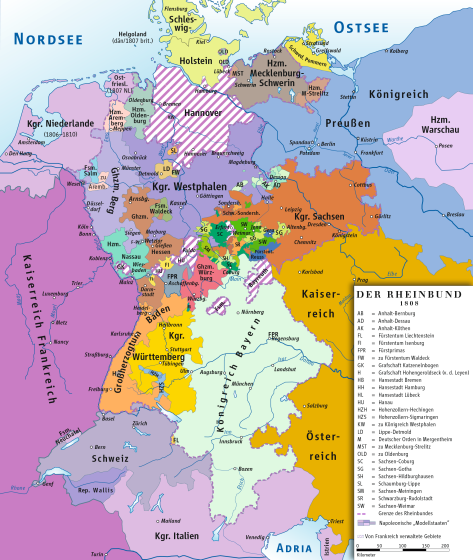
One important reason for Napoleon to create the Confederation of the Rhine was the troops and supplies these territories could provide for his armies. The members of the Confederation of the Rhine where allies of the French and fought as such in the War of the Fifth Coalition. On 10 April 1809, Britain and Austria declared war upon France and Bavaria. The British would fight mainly their Peninsular War in Spain and Portugal while the Austrians fought the French in Central Europe. The first major battle between the French and the Austrians was lost by the French. At the Battle of Aspern-Essling (21-22 May 1809) the French troops, which were led by Napoleon himself, were defeated by the Austrians under Archduke Charles. It was the first time in more than ten years Napoleon had personally lost a battle. However, the Austrians failed to decisively beat the French and the latter could retreat in good order. Two months later Napoleon got his revenge at the Battle of Wagram where his forces,among which many of the Confederation of the Rhine, defeated the Austrians decisively.
Once again the Austrians had been defeated and once again they had to cede land to France. At the Treaty of Schönbrunn, which was signed on 14 October 1809, Carinthia, Carnolia and the Adriatic ports went to France, while Salzburg came under the control of Bavaria (also: Poland gained Galicia and Russia got Tarnopol).
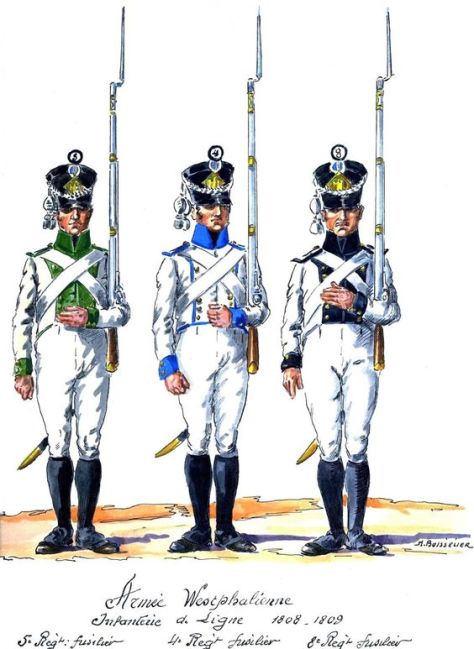
In 1812 Napoleon started his campaign against Russia with an army of over 600.000 men of which more than half of them were not French but came from the allied nations like the members of the Confederation of the Rhine. The Russia campaign turned out to be a disaster for Napoleon and his adversaries used the momentum to create another alliance, the Sixth Coalition which consisted of almost all countries in Europe that were not under French control. Napoleon replied in response that he would create a new army as big as the one he had sent to Russia and he did it even better. He achieved to put 900.000 men in the field against the new coalition throughout Europe and again a large part of this army was delivered by the Confederation of the Rhine. The French were not successful in this war and at the Battle of Leipzig (16-19 October 1813) they were decisively defeated by the armies of Russia, Austria, Prussia and Sweden.
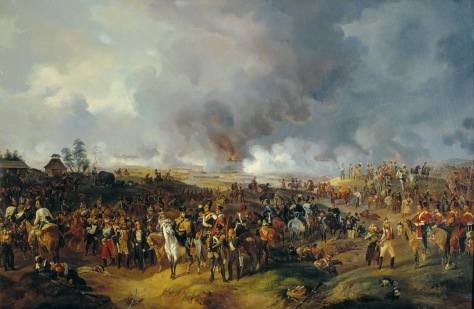
After the Battle of Leipzig the Confederation of the Rhine came to an end. Several of its member states switched sides and continued the War of the Sixth Coalition against France and on 4 November 1813 the Confederation of the Rhine was officially dissolved. After the signing of the Treaty of Paris, which ended the War of the Sixth Coalition, the German nations which were part of the Confederation of the Rhine were independent again.
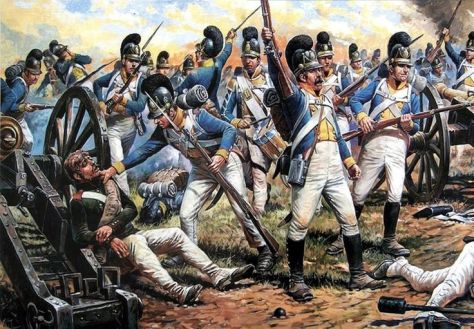
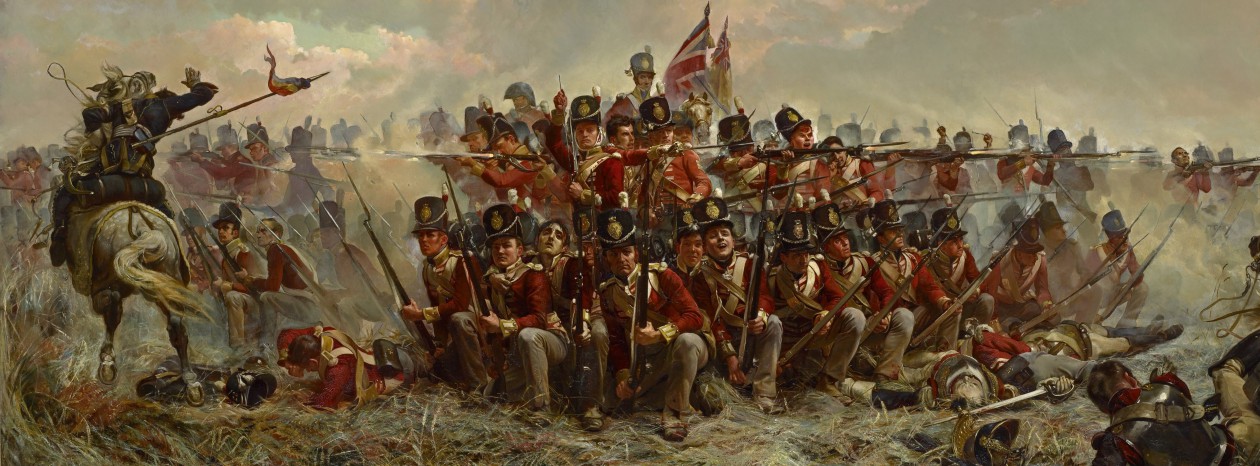
One thought on “Confederation of the Rhine 1806 – 1813”